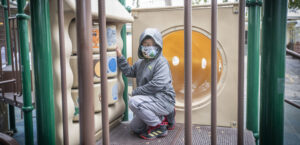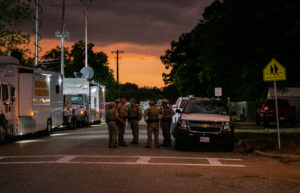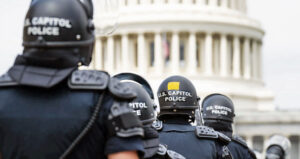Guns have been tied to American identity ever since the nation declared independence. But from Buffalo Bill to Rambo, the rugged, gun-toting individual has been mythologised by the gun lobby almost exclusively as a white male. And this myth was based on reality: five years ago, half of white men owned a gun — compared with a quarter of non-white men, and a quarter of women. A lot, however, has changed since then.
Gun violence is booming in the US. In the past three days alone, there have been reports that residents of Washington DC are afraid to walk five blocks, because “I don’t want to get randomly shot”; that a New Mexico governor has issued an emergency ban on bearing arms in response to gun violence; and that 60 congressional Democrats have signed an open letter to President Biden demanding that he use “every tool at his disposal” to combat the wave of gun-related deaths.
Within this culture of fear, guns are rapidly ceasing to be the preserve of white men. Since 2020, according to the National Shooting Sports Foundation (NSSF), there has been a 43% increase in Asian-American gun ownership, a 49% rise by Latinos, and a 58% increase among black people. And the diversification of gun ownership is intersectional: during the pandemic, Geneva Solomon, co-owner of Redstone Firearms in the Hollywood district of Los Angeles, said that she began noticing “an increasing number of black women, including single mothers and those living alone” coming to her shop to buy guns. “The desire to feel secure and empowered sparked a significant surge in interest,” she told me. Even before Covid, change was afoot, with the National African American Gun Association reporting that, since 2015, half of its new members are women.
Gun ownership increases when people feel threatened; it is well-documented that gun sales spike after mass shootings. Likewise, the increase in violence against people from non-white backgrounds during the pandemic has helped spark a national arms race. Attacks on people of Asian backgrounds in particular exploded, as political leaders began calling Covid the “kung-flu” and blaming China for unleashing it on the world. In liberal states such as California and New York, where large numbers of people from Chinese, Japanese and Korean origin have lived for generations, businesses came under attack and people were subjected to random assaults on the street.
The Latino population, who account for one fifth of new American gun owners, have some more complex, nebulous motivations for arming themselves. American Latinos, particularly those who speak Spanish at home, have traditionally been in favour of gun control. But that support has dropped precipitously. The desire to assimilate to their new lives as Americans has been cited as one factor, as has fear of hate crime. In Texas, where Latinos now outnumber white people, they are increasingly being targeted by white supremacist propaganda and are moving further to the Right — particularly along the Mexico border. There are signs that the same trend is taking place in New Mexico, where there are calls to impeach the Democrat governor trying to ban guns.
For African Americans, the question of gun ownership — something denied to them for long periods of American history — is thornier still. Black people remain the most targeted demographic for hate crimes in the country, while the number of black people killed by police has also increased in recent years. Civilian gun violence also takes a hugely disproportionate toll on black communities, particularly in disadvantaged areas. Between 2016 and 2020, more than 10 out of 100,000 black teens were murdered with guns; the equivalent figure for their white peers was 0.8, and for Latinos 1.9.
But if black people are arming themselves out of fear of violence, the inevitable result has been more violence. Josh Sugarmann, an anti-gun activist and founder of the Violence Policy Center, says that the real effects of a broadening gun ownership base is already having catastrophic consequences within the black community. “We’re starting to see the impact of putting more guns in homes,” he says, “especially as measured by suicide among black kids.” Last year, the gun suicide rate among black teens surpassed the rate of white teens for the first time on record. The most likely result of being armed, Sugarmann says, is that they will use their guns “against themselves, their friends or their family — and never to kill a criminal or stop a crime”.
While discrimination and violence are undoubtedly central to the changing demographics of American gun ownership, there is another factor at play. For the gun industry, expanding its ownership base has been an active project, and an existential one — bred of cold-blooded capitalism as much as radical ideology. Since the Nineties, the gun lobby has conducted an all-out assault to expand its market share, weaponising fear as part of a diversity push to expand its customer base.
Watching the extinguishing of the tobacco industry, the powerful gun lobby realised that failure to move with the times would see guns, like cigarettes, becoming a fringe vice that was looked down on by the general public. To survive, the industry would have to persuade citizens that its product is a mainstream commodity. Limiting itself to only the “pale, male, and stale” demographic was not only bad for its image — it was bad for business.
Naturally, it turned to advertising. White men would no longer be the focus. Women, people of colour, and the gay and lesbian communities were targeted with slogans such as “Equality? Brought to you by Sam Colt”, “Gun control once kept freedmen defenseless against KKK”, and, “99.8% of rapists polled prefer you unarmed”.
The industry hit their target. One recent study found that videos geared towards protecting women were viewed two-and-a-half times more often than videos that only featured men. Whether these were directly appealing to women, or to men keen on protecting women, isn’t clear. But these ads were onto something. Women’s gun ownership has almost doubled since 2007, from 13% of the population, to 22% today.
In 2015, the NSSF, which has overtaken the NRA as the key industry voice, held a summit. The theme was: Diversity. Its marketing chief Chris Dolnack said that the industry was focused on making changes “to embrace a new consumer audience”.
This increase wasn’t entirely down to the gun industry’s activities. Tragedies such as the Columbine High School massacre and 9/11 saw Americans of all stripes feel the need to be armed for self-protection. A woman firing off rounds in a bikini might look cute, but it’s fear and loathing that really sells — and wins votes. “Stand your ground” laws, where individuals have the right to use deadly force if necessary to protect against an intruder, have now been enacted in 38 states. People listened. Whereas in 2000, the majority of gun owners cited hunting as their primary reason for possessing a firearm, six years later, two-thirds said it was self-defence. By 2021, the proportion of people who said they purchased a gun for self-defence had risen to 88%.
What effect this shift in gun-owning demographics will have at the polls next year remains to be seen. It won’t necessarily benefit the Democrats. Gun owners, a historically Republican base, can still be in favour of harsher weapons restrictions and background checks, the traditional domain of Democrats: rights for me and not for thee has never been an unpopular position. And attempts to take on the well-funded and highly aggressive gun lobby have fallen short time and time again.
Addressing the broader social issues that have led many to gun ownership could, in theory, persuade some new gun owners to put down their weapons. But, if the past decades are a guide, there’s only so much politics can achieve here. There’s no getting round the second amendment: it’s baked into American history.
Disclaimer
Some of the posts we share are controversial and we do not necessarily agree with them in the whole extend. Sometimes we agree with the content or part of it but we do not agree with the narration or language. Nevertheless we find them somehow interesting, valuable and/or informative or we share them, because we strongly believe in freedom of speech, free press and journalism. We strongly encourage you to have a critical approach to all the content, do your own research and analysis to build your own opinion.
We would be glad to have your feedback.
Source: UnHerd Read the original article here: https://unherd.com/




